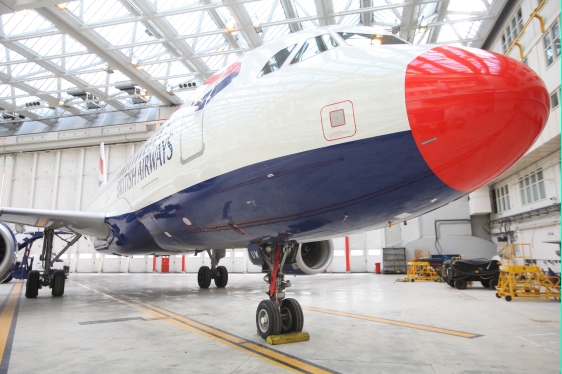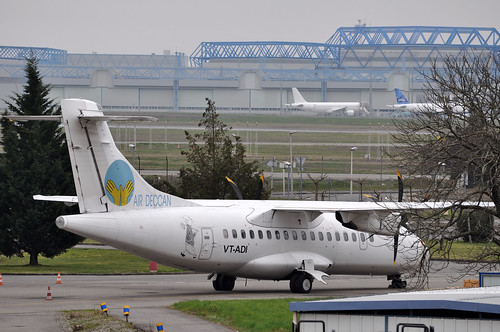..... Continued from yesterday. Read the first part.
Financials
For the third quarter ended December 31, 2008, SpiceJet declared a profit of Rs. 19.48 million. In today's economic meltdown, any profit is welcome.
 The financial statements have an explanation for a one time charge of Rs. 187.82 million.
The financial statements have an explanation for a one time charge of Rs. 187.82 million.
The Company entered into a Memorandum of Settlement (MoS) on November 26, 2008 with its erstwhile promoter S K Modi Group to settle various ongoing litigations with them. This settlement was approved by the Hon'ble High Court of Delhi on January 16, 2009. This settlement has resulted in one time nonoperational loss of Rs.188 million in the current quarter, shown under Extraordinary items, after adjusting for 8 million shares received by the Company pursuant to the settlement, valued for this adjustment at market rate as on the date of approval by the Hon’ble Court. Consequent to above settlement, qualifications in the audit report dated June 30, 2008 on accounts for the year ended March 31, 2008 pertaining to matters explained in paragraph 3.1, 3.5, 3.6 and 3.7 of schedule XVII of the accounts stands resolved. In respect of qualification pertaining to unaccrued interest as further explained in the paragraph 3.3 of schedule XVII of the accounts, the amount of unaccrued interest stands reduced to Rs.73.28 million. Had it been considered for accounting purposes, the loss reported for the period would have increased to Rs.252.92 million and the accumulated loss would have increased to Rs. 8,595.15 million
Thanks to gently recovering performance as outlined in
part 1 of this article, and the
$100 million cash injection by Wilbur Ross last year, SpiceJet has adequate cash.
Unlike most of its competitors, it is current to all the Oil Marketing Companies (Indian Oil, Bharat Petroleum, Hindustan Petroleum, etc.), airport operators, and lessors Babcock & Brown, GECAS, and ILFS.
For an in-depth look at the quarterly results and other financial information, please visit
MoneyControl.
The futureSanjay Aggarwal expects the downturn to last at least another 12 months, with recovery expected only by mid 2010. From the recent developments in world financial markets, IATA reports, and reports of precipitous drops in industrial output, one could venture to think, even that date is highly optimistic.
SpiceJet will not undertake fuel hedging for now. Sanjay expects oil to remain in the $30~$40 band till June 2009, and depending on the economic recovery $65~$70 in the first quarter of 2010.
SpiceJet will continue its cost cutting efforts which includes the phasing out of the expatriate pilots. The Indian Directorate General of Civil Aviation (DGCA) has set a deadline of June 2010 for all Indian carriers to eliminate expatriate flight crew positions, and Sanjay Aggarwal is confident of SpiceJet meeting that date.
International operationsSpiceJet will be completing its mandatory five year minimum shortly and will explore international operations as soon as fleet capacity and market conditions permit. The airline will restrict itself to ASEAN and the middle-east in line with its Boeing 737 fleet, and there are no plans for the far east, Europe or North America as of now. I can only hope SpiceJet draws inspiration from Air Asia X.
ConsolidationAs widely reported in the papers, Mr. Aggarwal feels the Indian LCC (low cost carrier) market is overcrowded with the current five airlines. He expects consolidation.
Speculation is also fuelled by the
appointment of Wilbur Ross and Ranjeet Nabha as Directors of SpiceJet, which should strengthen its relations with its investor WL Ross. Should the Government of India ever decide listen to IATA and open up the airline sector to foreign investment, SpiceJet is well placed to benefit from its WL Ross relationship.
SpiceJet is not actively seeking, but will explore consolidation opportunities (both to acquired and to be acquired) if a good deal comes its way. I quizzed him on the fact that other than JetLite (formerly Air Sahara), all other LCCs operated Airbus fleets and how would this affect the SpiceJet mantra of a single aircraft type.

Sanjay Aggarwal feels that once a critical mass of about 20 aircraft is achieved the costs can be justified in operating two different manufacturer fleets.
I however doubt that either Jet would like to part with JetLite, after having paid such a high premium when it acquired Air Sahara. IndiGo is a strong competitor, flies much the same routes and have the same base of New Delhi as SpiceJet, may not offer synergies. Air Deccan has now been fully merged with Kingfisher Airlines, and I do not see Dr. Vijay Mallya parting with his beloved airline. That leaves only the puny Go Air (market share 2.4 per cent). The
recently reported meeting between Jeh Wadia of Go Air and Sanjay Aggarwal, may be a step in that direction. However, with only four or five aircraft (best estimate since the Go Air website is silent on their fleet size), I do not see how the "critical mass" is achieved, but there may be other benefits to justify the deal.
The soft spoken, often enigmatic, and very elusive Sanjay Aggarwal is going to need every one of his 17 years of aviation industry experience to see SpiceJet through the next 18 months, which by any measure will be the toughest for any airline. However, all industry observers say, SpiceJet appears to have the best person for the job, already on the job.
 Cathay Pacific recently launched a promotional return fare of Rs 7,999 on its direct Delhi-Bangkok service, against a normal fare from other airlines in the range of Rs 15, 500-19,000.
Cathay Pacific recently launched a promotional return fare of Rs 7,999 on its direct Delhi-Bangkok service, against a normal fare from other airlines in the range of Rs 15, 500-19,000.
































